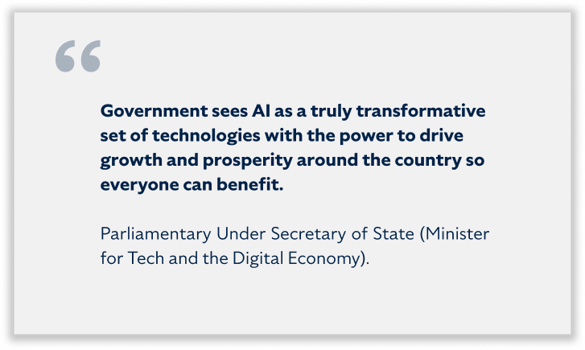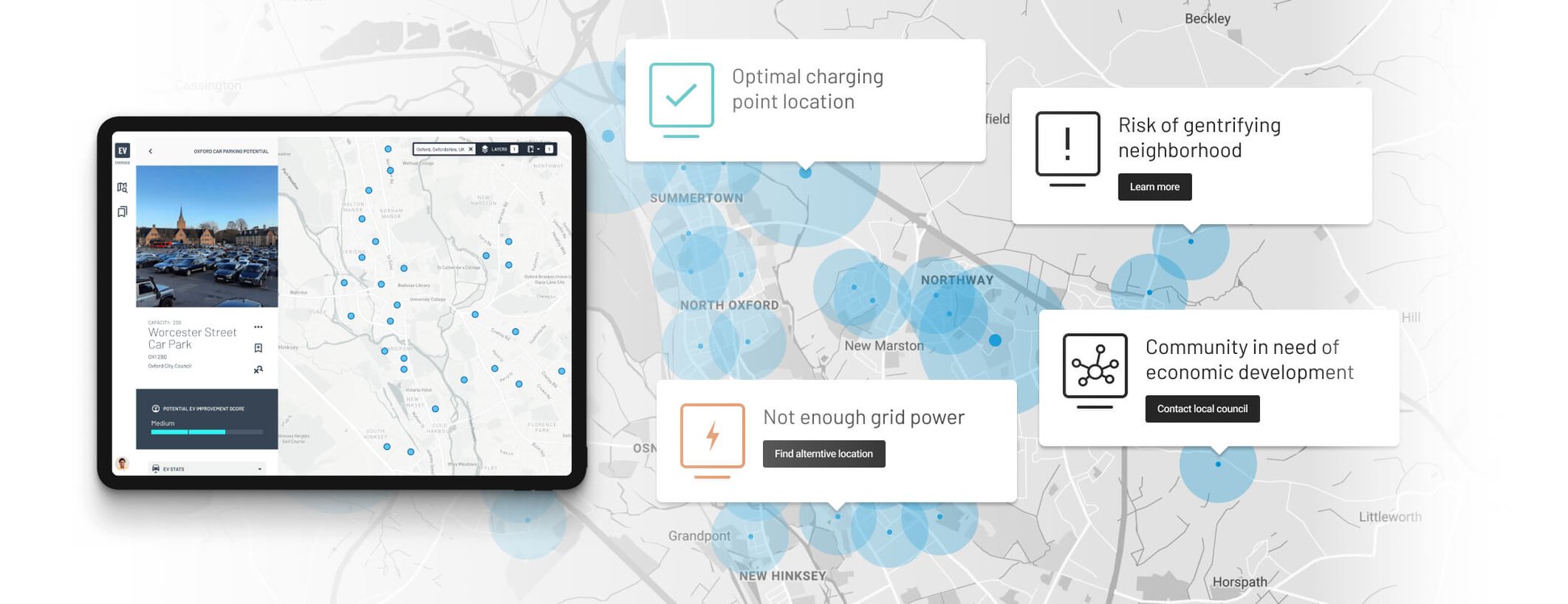Introduction
Artificial Intelligence (AI) is here. No longer merely a nebulous concept to occupy the minds of those in rarefied academic circles, AI is changing the way we live and work right now.
Today, AI is one of the fastest-growing technologies on the planet. Venture capital is flowing into the sector across the globe as new and innovative ways of harnessing its power are emerging as fast as they can be imagined. According to the World Economic Forum, “Artificial intelligence can transform government services, from preventing traffic congestion and providing speedy customer service to predicting crime and infrastructure failure".

The UK is home to some of the world’s foremost research establishments in the field and is already a leader on the global stage. Determined to capitalise on this advantage, the Government has taken steps to ensure the regulatory and business environment is in place to allow the sector to thrive, and for the enormous benefits AI can bring to make a positive impact across the entire country.
AI will drive true transformation throughout the public sector. It will enable organisations to make rapid gains in efficiency, improvements in the workplace, and ultimately allow for enhanced delivery of services and a better citizen experience. There remains, however, a degree of misunderstanding around AI and Machine Learning and its place in the public sector landscape. The technology, which is often misunderstood and confused for automation, is intended to support the workforce, not to replace it. Properly deployed, AI enables humans and machines to collaborate, working together to maximise its potential and achieve the best possible outcomes.
This article will consider the frameworks put in place by Government to promote the adoption and use of these exciting and innovative technologies. It will look at how AI can be deployed responsibly across an organisation and the enormous potential it can realise. Stressing the importance of such responsible implementation, it will demonstrate how choosing the right partner for the AI journey will ensure that systems are explainable and transparent, placing considerations for ethics at the core.
Complementary to the workforce, AI that is properly designed and deployed enables data-driven decisions to be optimised, improving outcomes for numerous stakeholders throughout society.

Preparing the Ground
Through a series of highly publicised reports, plans, and strategies, the UK Government has been very clear in signalling its intention to encourage a digital culture to flourish. The UK is home to more than 1,300 AI companies, an increase of some 600% over the last decade.
The public sector is ideally placed to reap the transformational benefits this innovation brings. Reaffirming its long-held desire to ensure Digital, Data, and Technology (DDaT) solutions are widely adopted and valued, the Government has outlined a series of ambitious initiatives to lay the foundations upon which a new, creative architecture can be built.
Beginning in September 2020, the findings of a far-reaching independent report into the Government’s DDaT function were presented by the Digital Economy Council, an examination of the challenges faced and ways to address them. Published as Organising for Digital Delivery, the report offers recommendations relevant to the whole of the public sector.
Outlining some of the barriers to realising the Government’s digital ambitions, it highlighted the problems associated with the maintenance of legacy IT systems, a cost of £2.3 billion per annum “just to keep the lights on”.
The report was taken seriously and informed several key strategies and policy decisions. In 2021, the Secretary of State for Digital, Culture, Media and Sport (DCMS) set out the Government’s 10 tech priorities. The announcement echoed plans to place DDaT at the forefront of the pandemic recovery, aligning with the Build Back Better agenda, levelling up the country and enabling the drive towards a regenerated economy: stronger, fairer, greener and with built-in resilience to unforeseen shocks.
 Special emphasis was placed on supporting the development and rollout of AI solutions. Heralding September’s National AI Strategy, the Digital Secretary explained, “Unleashing the power of AI is a top priority in our plan to be the most pro-tech government ever. The UK is already a world leader in this revolutionary technology and the new AI Strategy will help us seize its full potential - from creating new jobs and improving productivity to tackling climate change and delivering better public services.”
Special emphasis was placed on supporting the development and rollout of AI solutions. Heralding September’s National AI Strategy, the Digital Secretary explained, “Unleashing the power of AI is a top priority in our plan to be the most pro-tech government ever. The UK is already a world leader in this revolutionary technology and the new AI Strategy will help us seize its full potential - from creating new jobs and improving productivity to tackling climate change and delivering better public services.”
As a ten-year plan, the National AI Strategy aims to ensure Britain will retain its place at the top table of technological innovation and goes forward to become a global AI superpower. In publishing the strategy, the Government recognised that the widespread and expeditious deployment of AI throughout the entire economy was not merely preferable, but essential to the future success of UKPLC.
In early 2022, the DCMS and Office for Artificial Intelligence announced an initiative to shape global technical standards for AI. Piloted by the Alan Turing Institute, the AI Standards Hub will bring the AI community together to learn and benefit from shared global standards, ensuring the UK maintains its position as a world leader in the field. At its launch, the DCMS Minister for Technology and the Digital Economy said, “[It] marks the first step in delivering our new National AI Strategy and will develop the tools needed so organisations and consumers can benefit from all the opportunities of AI. We want the UK to lead the world in developing AI standards.”
You can learn more about I
The implicit message at the heart of these and other announcements is a call for the public sector to embrace the Government’s DDaT policies and strategies. In committing to substantial investment, the budget laid firm foundations. Leaders and key stakeholders are encouraged to experiment with, and adopt emergent and evolving technologies, to innovate, seek new creative solutions and explore the art of the possible.
 The public sector stands at the edge of great change. Widespread adoption of AI will scale at the speed of trust and bring efficiency, resilience and previously unimaginable improvements in performance. In order that trust can be built in from the outset, it is crucial that ethical considerations are placed at the forefront of any AI deployment. Leaders must ensure that any AI that is deployed must be powerful enough to operate reliably, but also be explainable, so that the people using it as well as those who are affected by it, can understand how and why it works in the way that it does. Their choice of AI partner should reflect their understanding of this importance and clearly signal their commitment to responsibility and transparency to the citizens they serve.
The public sector stands at the edge of great change. Widespread adoption of AI will scale at the speed of trust and bring efficiency, resilience and previously unimaginable improvements in performance. In order that trust can be built in from the outset, it is crucial that ethical considerations are placed at the forefront of any AI deployment. Leaders must ensure that any AI that is deployed must be powerful enough to operate reliably, but also be explainable, so that the people using it as well as those who are affected by it, can understand how and why it works in the way that it does. Their choice of AI partner should reflect their understanding of this importance and clearly signal their commitment to responsibility and transparency to the citizens they serve.
Thinking AI: The Art of the Possible
 In the decades that followed Turing’s foundational work on theoretical computer science, the progress of AI could be described as slow but steady. A number of landmark achievements signalled the direction of travel, but the pace of development was limited by two key factors: how much data was available and access to the computational power required to learn from it. It is only relatively recently that advances in computing power and the vast accumulation of data driven by the internet economy have enabled significant gains to be made simultaneously on both fronts. Once depicting shallow growth, the development curve has rapidly steepened in recent years.
In the decades that followed Turing’s foundational work on theoretical computer science, the progress of AI could be described as slow but steady. A number of landmark achievements signalled the direction of travel, but the pace of development was limited by two key factors: how much data was available and access to the computational power required to learn from it. It is only relatively recently that advances in computing power and the vast accumulation of data driven by the internet economy have enabled significant gains to be made simultaneously on both fronts. Once depicting shallow growth, the development curve has rapidly steepened in recent years.
For much of the public sector, the AI journey is in its early stages. Organisations are tentatively starting to experiment with the technology and consider where and in what ways it can be deployed to maximise potential. In a wide-ranging survey of public sector leaders conducted by Mind Foundry, in collaboration with GovNews, it was found that 39% of responders have at least one project running with another 17% actively trialling solutions. There remains, however, a considerable knowledge gap. The survey also found that 64% had been unable to make a business case for AI. This indicates that many have yet to fully grasp its potential, evidenced by a startlingly high figure of 77% who stated a need to upskill their teams to understand how the technology works. Despite this skills gap, AI applications are already having measurably profound impacts where they are deployed. By reframing the art of the possible, innovative organisations are harnessing the immense power of AI today.
At this stage, to clarify what may be a fundamental misunderstanding, it is perhaps valuable to consider a definition of AI. The Central Data and Digital Office (CDDO), in its document, “A guide to using artificial intelligence in the public sector”, defines AI as: “The use of digital technology to create systems capable of performing tasks commonly thought to require intelligence”.
The guidance from CDDO goes on to explain that although the technology is evolving, the potential of AI technology is applicable in finding previously undiscovered/underlying patterns from large volumes of data.
The public sector is increasingly driven by data. The sheer volume accrued is barely comprehensible. Thanks to the exponential growth of digitalisation, the ever-increasing demands of an “always on” culture, and the determination of the Government to pursue “digital by default” strategies, citizens are accessing services at a time and place of their choosing via a growing multiplicity of devices. Each and every interaction adds to the data landscape, enabling an immense and hugely detailed picture to be built.
The quantity is simply too vast to be processed by the human mind. However, it provides the fuel to power seemingly innumerable AI solutions which enable data-driven decision-making. A scenario emerges in which a best-of-both-worlds outcome becomes possible.
Human-AI collaboration allows for empathy and ethics in decision-making while working to eliminate inherent biases. In tandem with other emerging technologies, the possibilities appear almost endless, limited only by what uses can be imagined.
|
AI enables highly accurate modelling and forecasting, allowing for changing requirements to be predicted and optimised outcomes. |
|
|
Complex simulations can be provided ahead of trialling policy options, identifying unintended consequences and helping to build in resilience prior to committing to a measure. |
|
Able to provide a high level of data granularity, AI can personalise public services and adapt to an individual’s circumstances. Ultimately, an enhanced service is provided at a cost that would once not have been feasible. |
|
Back-office processes become automated increasing efficiency. Staff members are freed to concentrate on more interesting, value-added tasks, improving workplace morale and unleashing creativity. |
Research suggests the public is already generally onside. In a report published in March 2022, the Centre for Data Ethics and Innovation (CDEI) tracked how attitudes to data and AI have changed over time. Perhaps driven by pandemic-related increases in online interactions, the figures show a majority of 62% are comfortable providing personal data to access public services, a number which rises to 81% when information is shared with health and care providers.
Working with Legacy Technology
The public sector IT estate is vast and complex. Divergent solutions have evolved over a period of many decades and, as we have seen, legacy systems are a natural weak point in many organisations.
 The Organising for Digital Delivery report stated that half of the £4.7 billion annual spend on Government IT is required to maintain obsolete systems, some of which are three decades old. It is, of course, unrealistic to consider a wholesale replacement, the cost of which would be prohibitive.
The Organising for Digital Delivery report stated that half of the £4.7 billion annual spend on Government IT is required to maintain obsolete systems, some of which are three decades old. It is, of course, unrealistic to consider a wholesale replacement, the cost of which would be prohibitive.
Legacy systems do not, however, present a barrier to the deployment of AI. Integrated AI solutions can sit in front of and alongside existing data platforms and work to eliminate silos, actually enhancing performance and reliability. AI software can bridge existing tech with common interfaces, simplifying the process for users and reducing the need for support services.
Due to the sheer size of the public sector, it is inevitable that AI will have to be deployed alongside legacy systems. This does not present a roadblock. Large-scale investment in system replacement is not necessary for proof-of-concept trials and further rollout. There is no need for teams to reinvent the wheel. Transformation through AI is achieved through an evolutionary process, with systems deployed incrementally and scaleable to meet changing requirements. AI grows organically, becoming a component part of the existing infrastructure.
By working in collaboration with the right partner, organisations can experience significant gains without the necessity to rebuild the existing IT architecture.
Conclusion
A fast-moving technology, AI remains at its core a way of using machines to find patterns in large amounts of data. It can perform tasks, highlight important insights, and improve our ability to make sense of the world. It is not a set-and-forget technology, but can be developed to learn continuously and actively improve from human input or changes in data. It can increase our productivity, empower unimagined service enhancements, and help citizens to access a wider range of services more quickly than they have ever been able to. Such power, however, must be wielded with great care to ensure that it remains aligned with its defining principles and the greater goals and values of the people who are most affected by it. By partnering with a provider that prioritises ethics and responsibility, organisations can deploy AI responsibly in the public sector to improve human outcomes.
AI delivers the future. By making the right digital choices today, the power of this truly innovative technology is unleashed for tomorrow and beyond. A world of immeasurable possibility is presented, bringing continuing gains in efficiency, productivity, workplace morale and delivery of services to UK citizens.
Case Study: Optimising Infrastructure
In 2019, the UK became the first major world economy to sign into law a commitment to reduce greenhouse gas emissions to net zero and end its contribution to global warming by 2050.
A series of policy decisions followed, including plans to reduce transport emissions by ending the widespread use of internal combustion powered vehicles. In order to accelerate the transition to electric vehicles (EVs), the Government has confirmed it will no longer be possible to buy a new petrol or diesel car in the UK from 2030.
Supportive of these aims, leaders at Oxfordshire County Council prioritised their response, working with a number of other local authorities and partners to contribute to a wide-ranging study researching ways to meet the challenge.
The county already boasts an above-average uptake of EVs, with registrations of zero-emissions vehicles growing by 50% each year. The overall number, however, remains low, with “range anxiety” and concerns over charging being significant factors.
To try to allay some of these concerns and further promote the use of EVs, the council looked at ways to optimise its charging infrastructure. Working in collaboration with Mind Foundry, the council undertook a project using geospatial modelling in tandem with a variety of data sources to optimise infrastructure budgets and ensure ethical considerations for local communities.
By using the Mind Foundry Platform, new scenarios can be visualised to give the council a valuable insight into potential problems before they develop. Resource deployment is optimised and strategies informed.
Read the full case study here.

Contact us today
Learn more about how we can help you bring the benefits of AI to your organisation.
4 min read
Let’s Use AI Responsibly to Discover Where to Place EV Charge Points
William Chapman:
Stay connected
News, announcements, and blogs about AI in high-stakes applications.

